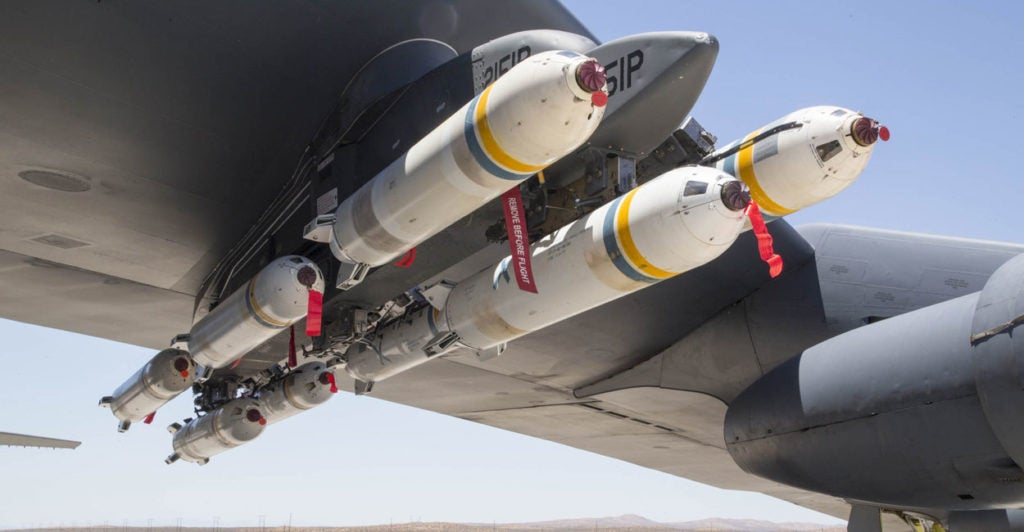The Pentagon drew sharp but unwarranted criticism earlier this month following its decision to indefinitely delay compliance with a ban on certain kinds of legacy cluster bombs.
Cluster bombs remain an important tool in the arsenal for U.S. forces, as they are effective at targeting light armor, massed infantry, and parked aircraft. We should not deny our forces the use of this capability until we have an adequate substitute.
The Convention on Cluster Munitions, an international treaty, prohibits the use or stockpiling of this weapon. Significantly, Russia, China, North Korea, and Iran have not ratified the treaty.
The George W. Bush administration, recognizing the continuing importance of cluster munitions to U.S. defense needs, also refused to sign the treaty, but set a deadline of 2018 for the U.S. to move to cluster munitions with a very high degree of reliability.
This policy sought to eliminate cluster bombs whose sub-munitions detonate less than 99 percent of the time. This reduces the risk that unexploded ordnance poses to noncombatants.
The Pentagon has cluster munitions that meet this degree of reliability, the Sensor Fuzed Weapon, for example, but its large stockpiles of legacy cluster munitions would be useless at the 2018 deadline as legacy munitions do not meet that standard.
Though the 2018 deadline was set 10 years ago, the Obama administration showed no urgency in developing adequate replacements.
Today, those replacements are still under development. The military therefore took the only viable course of action by delaying the ban and keeping this weapon, while continuing to work toward developing new munitions that pose no risk of leaving any unexploded ordnance.
Rather than recognize the military’s decision as a reasonable approach to maintaining readiness while it continues to upgrade its arsenal, media outlets and politicians have lambasted this decision as “unbelievable,” in the words of Sen. Dianne Feinstein, D-Calif.
This issue has risen in prominence due to recent allegations that U.S.-made cluster bombs, bought by Saudi Arabia, caused significant civilian casualties in Yemen.
In April of this year, Feinstein and Sen. Patrick Leahy, D-Vt., introduced the Cluster Munitions Civilian Protection Act to bind the Defense Department to the 1 percent maximum failure rate for cluster bomb detonation. It is also intended to put the U.S. on the path toward compliance with the Convention on Cluster Munitions.
This is a short-sighted approach. The Feinstein-Leahy bill, like the Convention on Cluster Munitions, would impose a stringent standard for cluster munitions on the military and would leave the United States without cluster munitions until new munitions can be developed and fielded.
Furthermore, it ignores the important steps already taken by the U.S. government and military leadership to address humanitarian concerns about cluster bombs.
With respect to Yemen, the Obama administration halted U.S. supplies of cluster munitions to Saudi Arabia, which faced international pressure for its targeting practices.
The reality is that even cluster munitions with miniscule failure rates can inflict civilian casualties if used improperly. Thus, even when the Pentagon has only cluster munitions with a 99 percent activation rate, there is still no assurance that the munitions will be used in accord with the laws of war.
Beyond that, most critiques of the Pentagon’s compromise policy ignore the fact that it now requires new purchases of cluster munitions to either have a less than 1 percent failure rate, or have self-destruct mechanisms that will be triggered after firing.
The Pentagon’s new policy has not, therefore, departed from the original goal of designing safer and more reliable cluster munitions. The policy rightly allows the U.S. military to maintain the capabilities necessary to counter masses of conventional forces should a future wartime scenario require it.
This is a prudent and defensible approach. The United States has used cluster munitions sparingly in recent decades, but they could be vital in a military situation involving large concentrations of conventional forces.
It would be reckless to destroy a valuable and well-established asset before its replacement is deployed.
